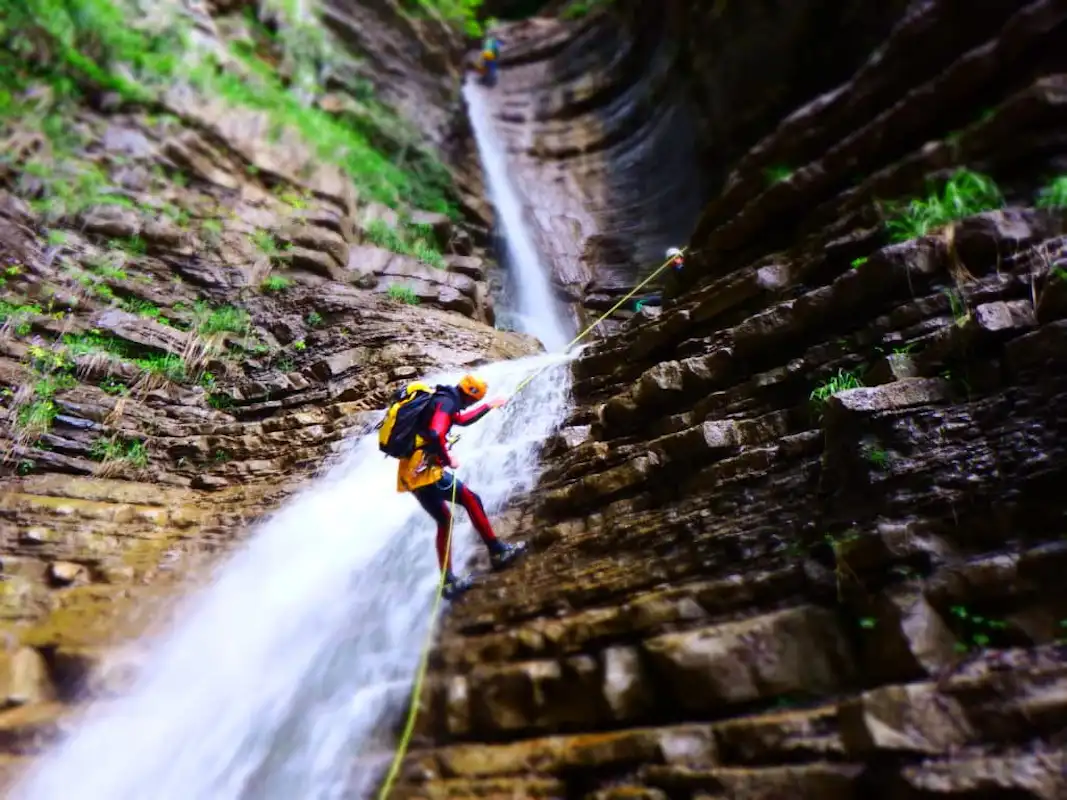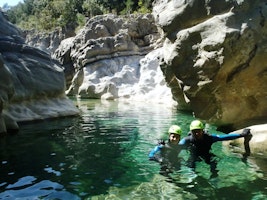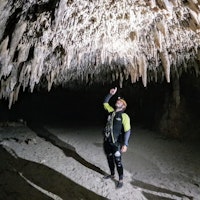Carlos Vidal Arque is an AEGM Mountain Guide from Spain, specialized in rock climbing and canyoning.
Lying to the south of the Pyrenees, in the singular region of Aragon, outdoor lovers will find a place that boasts a deep mountaineering culture and a passion for canyoning. Sierra and Canyons de Guara Natural Park provides a unique opportunity to discover Spain’s authenticity while jumping in the translucent turquoise water of canyons.
If you haven’t heard about canyoning yet, here’s what you need to know:
Canyoning is an outdoor activity which consists on following a riverbed and explore the ‘technical areas’ where we’ll find challenges to overcome by combining swimming, jumping, diving, climbing, walking and rappelling.
The limestone mountain massif of Sierra de Guara, in the province of Huesca, features some of the most beautiful canyon descents in Europe. It’s also the origin of canyoning in Spain, which was introduced to the country by the French. Some canyons in the area, like Rio Vero or Mascun, are considered mythical and have contributed to recognize Spain as a first-class canyoning destination.
In the past, the French pioneers had neither maps nor topos to help them explore and locate the canyons. They used to climb them backwards against the current and without any suitable equipment. Now, thanks to high-quality equipment and advanced guiding skills, people of all levels and motivations can enjoy privileged moments in a preserved natural environment.
Ready to explore amazing natural pools and waterfalls? Join me for one or several days of canyoning in Sierra de Guara!
Here’s a selection of the most outstanding canyons we can visit on this Natural Park:
THE BEST 5 CANYON DESCENTS IN SIERRA DE GUARA
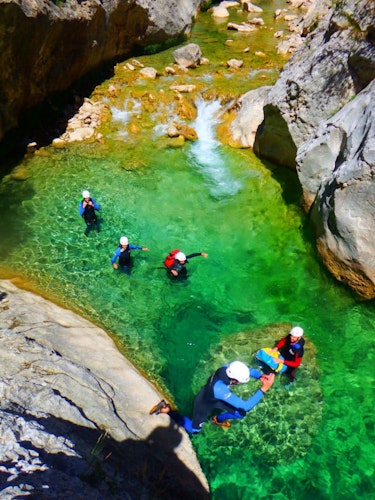
Having fun at Péonéra Canyon. Photo: Carlos Vidal Arque
1| RÍO VERO
Approach: 1 hour. Return: 20 minutes
Where the history of canyoning begins! This amazing canyon contributed significantly to make Sierra de Guara known as a canyoning destination. The sheer size and beauty of the cliffs gives it the appearance of a true natural museum. Technically easy, it consists of finding the path along four big chaos of blocks. Those make this descent very playful and aquatic: like a mineral labyrinth made of small slides, snorkeling and jumping (all bypassable).
The canyoning trip ends at the famous medieval village of Alquezar, which adds a cultural touch to the journey. It’s an ideal tour for families and lovers of grandiose landscapes.
2| PÉONÉRA
Approach: 1 hour. Return: 30 minutes
Péonéra Canyon is one of the most popular in Sierra de Guara. The descent begins with a series of cascades. Naturally shaped by water erosion, this canyon offers many surprising passages: an aesthetic chaos of blocks, long swimming passages, a wide variety of jumps and siphons (all bypassable). Half-way, at Tamara’s natural pool, we follow a descent by a small and conglomerate canyon named Puntillo. After a little chaos, the river opens onto a very pretty basin where you can practice jumps of different heights in an emerald green translucent water. No rappel.
3| BALCÈS
Approach: 1.5 hours. Return: 30 minutes
The hidden diamond of Sierra de Guara! This very complete canyon is located in the wild area of Rio Isuala valley. After a walk in a very mountainous setting, we will reach the bottom of a valley bordered by high cliffs of orange limestone and grey caves with bright colors. The Balces canyon begins with a chaos of blocks and a rappel of 8 meters. Then follows small down climbing sections, slides, and some optional underwater passages. It also provides access to the most incredible moment of the descent, which is unique in Sierra de Guara: a one meter corridor with a hundred meters wall side, sculpted by million years of water erosion. Another 5-meter rappel allows you to get out of the gorge and finish the canyon in a beautiful pool. There are two rappels which don’t exceed 8 meters.
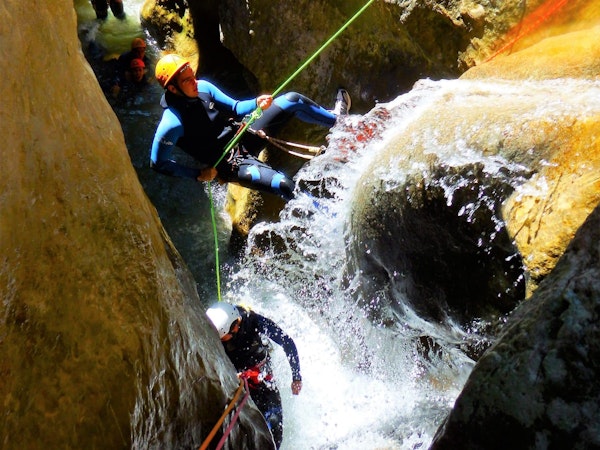
Rappelling at Oscuros de Balces canyon. Photo: Carlos Vidal Arque.
4| FORMIGA
Approach: 1 hour. Return: 10 minutes
Here is the most representative canyon in Sierra de Guara. Embedded in a conglomerate gorge, its descent is very complete and connects playful passages accessible to all. Physically approachable, it enables to learn gently the basic rope techniques, while offering many fun passages. After a pleasant walk overflew by griffon vultures, the path begins with a rappel before reaching the water. What comes next is aquatic: slides, small optional jumps and dives. Two rappels of about 7 meters give this descent a technical character. The end of the canyon –more open and sunny– offers beautiful canyoning passages, which can be very different depending on the water level. Maximum 3 rappels (up 7 meters).
5| VIRGEN CANYON AND PETIT MASCUN
Approach: 20 minutes. Return: no walking back time
Starting from Rodellar, this combination of two small but complete canyons is an ideal option for spring, and perfect to enjoy on one day how the spirit of canyoning merges with the climbing culture of Rodellar. Virgen is a dry canyon that stands out for its aesthetics. Ideal for learning rappelling techniques, it consists on a series of small steps with smooth and sculpted walls. At the end of this first canyon, you will reach the lower part of Mascun. The descent continues in the water, exploring chaos of blocks full of easy passages: jumps, small caves, waterfalls…! Large magnificent cliffs border the canyon until you reach Barrasil river and the sign indicating El Puente Campsite, the end of the itinerary. Maximum 3 rappels (up 10 meters).
EXPERT CANYONS!
Particularly long and physically demanding, the expert canyons are great mythical expeditions of canyoning in the Spanish Pyrenees. With several hours of walking and activity, they require a very good athletic condition and are only addressed to the most experienced.
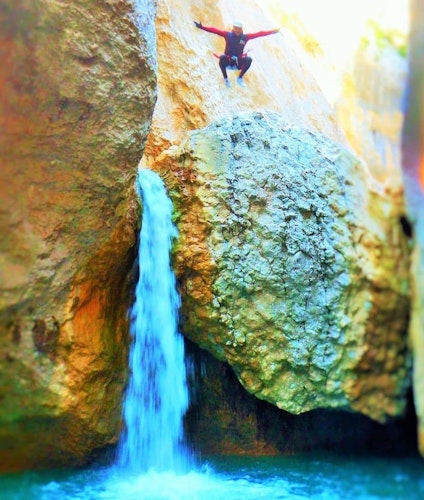
Jump! Gorjas Negras, one of the classics in Sierra de Guara. Photo: Carlos Vidal Arque.
1| MASCUN
Approach: 3 hours. Return: 1.5 hours
The mythical, almost magical canyon of Sierra de Guara. It was named “Maskhrun” by the Arabs, which means “the witches’ dwelling”, in reference to the grandiose landscapes bordering its flanks. From the village of Rodellar, a very sporty walk lead us to the desert plateau of Sierra de Guara, where a perfect circus makes the starting point of the descent. It is a long and complete canyon (jumps, rappels, swims), also revered by its aesthetics. Its difficulty is given by its length and the number of rappels. The best time to go there is at the beginning of the season: from May to mid July. It is generally dry the rest of the summer. A dozen rappels, from 5 to 20 meters.
2| BARRASIL
Approach: about 2 hours. Return: no walking back time
A wide and wild gorge carved out in the Sierra de Guara plateau. Starting from Rodellar, we’ll take the Andrebot hiking trail. This canyon provides a big chaos of imposing blocks as we sail from waterfall to waterfall, bordered by majestic cliffs. There’s some hiking and swimming (with no technical difficulty) and you can practice jumps at various heights from 2 to 10 meters (all bypassable). The tour ends swimming in a majestic natural corridor that leads directly to El Puente Campsite. A day free of stress, perfect to enjoy the calm. A river hike where you can enjoy the sun and practice canyoning techniques with your family and kids. No rappels.
3| OTÍN
Approach: 1.5 hours. Return: 1 hour
Extremely beautiful, this dry and vertical canyon is a series of rappels opening to a vertical and wild setting. After a superb hike towards the abandoned village of Otin, we go into the gorge that is devoid of water but aesthetically sculpted. The descent is a succession of rappels, more or less high and technical, which require a little experience in rope descent and reveal an imposing view of the gorge. This canyon is banned in spring because of birds nesting, and therefore runs during the summer period. It is an ideal option to take a break from a series of aquatic canyons, with a still exciting and sporty option. A dozen rappels, including two of 45 meters.
4| GORGAS NEGRAS
Approach: 3 hours. Return trip: 10 minutes
Wild and physically engaged, this descent is regarded as the longest one in Sierra de Guara. A super sporty (and classic) challenge! This 21 km canyon provides plenty of hiking and swimming, with many jumps and rappels. A great option if you’d like to stay away from the crowds of the big weekends during the summer break. As for Mascun, the approach starts from the village of Rodellar and strides West to reach the abandoned village of Nasarre. The entrance ―an impressive gorge which cuts the mountain in two― leads to a very impressive section: a succession of jumps that can also be rapelled down. The second part, more open, reveals a majestic landscape and the last optional jumps of the descent. A few rappels not exceeding 12 meters.
***
Yes, it’s hard to decide! That’s why I put up this 5-day canyoning tour in Sierra de Guara, tackling a different canyon every day, plus enjoying a pic-nic in nature! I can adapt this program to the group’s interests, ages and levels.
And in case you’d like to explore other venues beyond Sierra de Guara, you can also check out my program for 1+ canyoning days in Catalonia, Aragon or the Spanish Pyrenees!
CANYONING WITH KIDS: A NATURAL PLAYGROUND
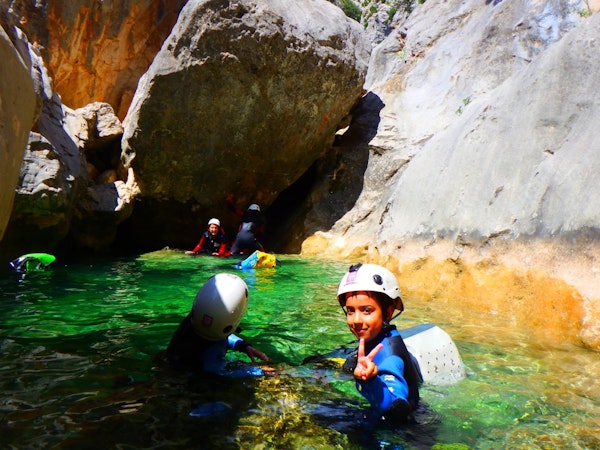
Kids in Peonera Canyon. Photo: Carlos Vidal Arque.
Sierra de Guara is a unique venue to practice this playful, fun and aquatic activity with children. Children can start canyoning at a very early age. Swimming, jumping, diving… it’s all part of their genetics! However, they usually don’t enjoy hiking very much.
Children from 8 to 10 years old can try canyoning, as long as they can hike 30 minutes in the mountain.
Canyoning in Sierra de Guara is also an opportunity to discover a natural environment of extreme beauty and to share an unforgettable adventure with your family.
It’s possible to adapt the itinerary to children so the canyoning day remains a pleasure. We can moderate or avoid the difficulties of jumps from different heights (always avoidable), swims (the neoprene suit acts as a swimming ring that improves floatability), rappels and other features like natural slides, caves and waterfalls.
Besides, it’s worth mentioning that the water of the canyons of Sierra de Guara is warm compared to the canyons of the Pyrenees, because it does not come from snow-melt, but from springs fed by winter precipitation.
WHAT EQUIPMENT DO I NEED FOR CANYONING?
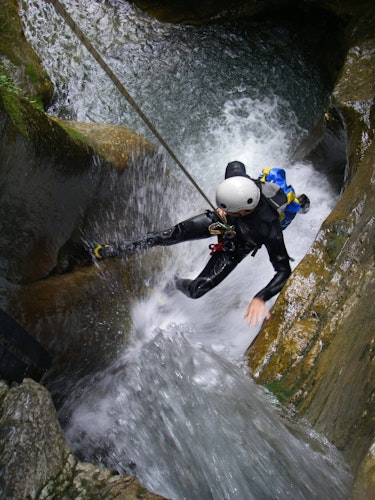
Wetsuit and helmet are part of the essential equipment for canyoning. Photo: Carlos Vidal Arque.
Technical Canyoning Equipment
Some of these items are required by the Natural Park, while other are important for comfort and logistics. In general, the technical equipment is included on the guide’s prices, but there are also many places where you can rent or even buy some gear.
Canyoning wetsuit. These 5 mm neoprene rugged and comfortable suits usually come in two parts, a jumpsuit and a jacket. Most of them have elbow, knee and buttock protections.
Helmet. Comfortable, light and quick to adjust, helmets perfectly fulfill their essential role in the safety equipment for canyoning. They must comply with the European Standards for Personal Protective Equipment (PPE).
Self-emptying bag and waterproof container. The 6 liter waterproof cans keep your picnic and your belongings dry during the activity. Generally, one is enough for two or three people. Each can be placed in a comfortable and practical bag of 35 liters capacity designed for the canyoning activity.
Rappelling gear. For canyons that require descents on rope each person needs a harness equipped with a descender (the eight), two lanyards and two carabiners, which comply with the European Standards for Personal Protective Equipment (PPE).
Non Technical Equipment
Closed-toe shoes: they must ensure a good protection of the foot, like sneakers or hiking shoes (avoid not adapted shoes like sandals, flip-flops, windsurfing shoes, beach shoes).
Water bottle: 1 litre per person minimum.
Pic-nic: a meal for lunch and energy snacks.
Swimsuit
Light and warm clothing for the approach and return walk.
Eyeglasses: the best is to secure them with a string. Contact lenses are also perfectly suited.
Specific medical treatments if necessary.
BEST TIME FOR CANYONING IN SIERRA DE GUARA
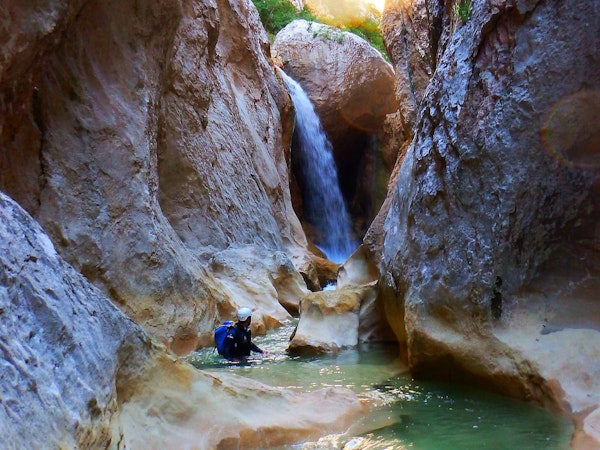
Gorjas Negras canyon. Photo: Carlos Vidal Arque.
Sierra de Guara has a microclimate, with a mix of Oceanic and Mediterranean weather. In winter, there are heavy rains and cold temperatures; while summer boasts generous sunshine, warmer air and water temperatures.
The ideal time for canyoning goes from the beginning of May to the end of September. Each season is different depending on the weather and the water levels in the canyons.
From May to September, we distinguish 3 periods in which conditions may vary:
MAY-JUNE. A period often quiet in terms of attendance, water levels can be high, and canyons rather athletic. Weather conditions and temperatures can be variable, so we discourage this period for young children. The beginning of the season is ideal for expert canyons and those which become dry during the low period (Mascun-Fornocal-Virgen/Petit Mascun).
JULY-AUGUST. Is the best time for canyoning as it combines a good balance between water level conditions and summer temperatures. Every year some thunderstorms happen and replenish the canyons. July is often a little quieter than the first three weeks of August. Overall, it is the perfect time to make a family holiday with children. August brings together the best conditions.
SEPTEMBER. A fairly quiet period. Water levels are often low but sufficient. However, you have to be aware of weather conditions, because autumn can come very quickly and refresh the atmosphere. Canyoning relies on factors we can’t control. Each river and canyon is fed by natural sources, which are supplied by winter precipitation. In general, a low rain does not affect the flow of the river or its color. However, heavy rains and thunderstorms can dramatically alter the appearance of the canyon and make the descent perilous.
FAQs
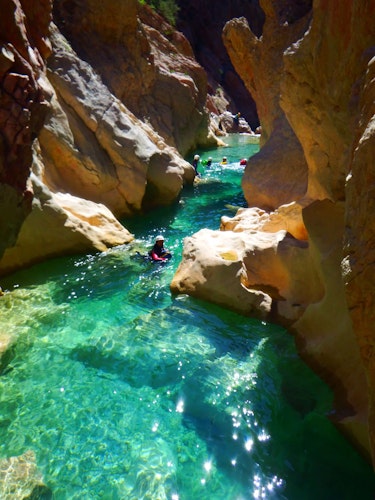
Turquoise waters at Peonera Canyon. Photo: Carlos Vidal Arque.
1| Should I be ultra fit for canyoning? Canyoning is technically accessible to everyone. Besides, it is possible to adapt the choice of canyon, progression speed and itinerary to the group level. It is not compulsory to be a great athlete to practice canyoning, nevertheless there is two prerequisites: 1) be prepared to provide a minimum of physical effort and 2) do not be afraid of water.
2| I don’t like to jump and dive. Is it possible to avoid it? Jumps are never mandatory, it is always possible to bypass them by rappelling. Underwater passages or dives can also be bypassed, sometimes by an alternative pass or sometimes by climbing. Not always the bypass options are going to be easier than the dive or the jump.
3| We are sporty but beginners. What canyon should we do? For a first approach to Sierra de Guara, we advise you to choose an easy canyon to understand the activity and practice the basic techniques. FORMIGA and VIRGEN-PETIT MASCÚN are the best option.
4| Where to stay in Sierra de Guara? Rodellar, Alquezar or Bierge are the most popular places in Sierra de Guara, ideal to stay near the canyons. There’s also a big offer of small towns (Asque, Adahuesca, Alberuela de la Liena) with some accommodations if you want a quieter place.
5| Which other activities can I practice in the area? According to your preferences, you can enjoy the richness of gastronomy, culture, nature or other sports. Here are some ideas:
Museums. Among others, there’s a museum on Raptors in Santa Cilia, fauna and Flora in Bierge, rock art in Colongo, legends and traditions in Adahuesca.
Parietal Art. The rock art of the Sierra de Guara Park, which has more than 60 caves listed, has been integrated into the rock art of the Mediterranean Basin and declared a UNESCO World Heritage Site.
Ornithology. Sierra de Guara is a unique place for ornithology enthusiasts. It’s Aragon’s largest protected natural area and one of the major ornithological reserves in Europe.
Rock climbing. The areas of Rodellar and Alquezar, which now have several hundred bolted roots, have become a world-class climbing spot.
Hiking. Sierra de Guara Natural Park proposes a wide range of listed hikes which will allow you to discover unique and grandiose sceneries, to observe fauna and the flora and to access privileged bathing spots.
Mountain Bike. There are 13 mountain biking itineraries to explore the diversity of the Sierra de Guara. You can combine several of these courses and gain in intensity.
Are you ready for canyoning in Sierra de Guara? Book a certified mountain guide for a super fun outdoor adventure in the most beautiful canyons in Spain!
